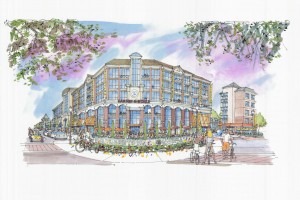
Courtesy of Fairmount Properties
A $20 million federal loan was approved for UR’s highly anticipated College Town project on Friday, Sept. 29, the latest development in the loftily-touted project that could potentially clear the last remaining hurdle before a groundbreaking this November after months of tentative progress.
The $140 million project would create a vibrant, 16-acre business district between Crittenden Boulevard and Elmwood Avenue and will include such amenities as a two-story Barnes & Noble, restaurants, gourmet food markets, office space, a 150-room hotel, a conference center and a parking garage.
The loan was secured from the U.S. Department of Housing and Urban Development (HUD) and was announced by U.S. Senator Charles Schumer, who called upon HUD Secretary Shaun Donovan to make a decision on the loan by the end of September.
Although UR will own College Town’s property, the property tax it generates will be used to repay the HUD loan for its first 20 years.
The University’s Senior Vice President for Administration and Finance Ronald Paprocki said that the approval of the loan is a “milestone event” for the College Town project, lauding the help of Schumer for pushing for a decision by Sept. 30. Paprocki said that Friday’s decision was “right on target” and added that in another positive step toward completion of the project, UR signed a development agreement with College Town developers this summer.
“We have agreed to all of the significant terms, including the terms for the ground lease that we hope to sign in November prior to commencement of construction,” Paprocki said. “The final conditions to be met are all being worked on.”
He added that the developer has also submitted a site plan to be approved by the city of Rochester, a site plan to be approved by the City of Rochester, a process that is also on target.
“We are more optimistic than ever that we will see a groundbreaking in November,” he said.
Concurrent with developments on College Town, expansive improvements to Mt. Hope Avenue are underway that have been snarling traffic on the thoroughfare this fall.
Senior Engineer for the city of Rochester Paul Way said that the Mt. Hope improvement project, which has been in the planning stages for several years, will join seamlessly with College Town.
“They are two distinct programs, but there is definitely a linkage between the two — the two are being done with full knowledge of and in concert with the other,” Way said. “College Town as a private development will mash and blend perfectly into the public improvements on Mt. Hope construction.”
Construction began on Mt. Hope this April and is proceeding on schedule, Way said.
The city decided to spend slightly more money on a contractor in order to complete all of the construction, including all of the traffic signals, crosswalks and medians, except for the final top coating of pavement and some final landscaping by the end of this year, Way added.
“The quicker we get it done, the better it is for the businesses and everyone in the corridor,” Way said. “We decided to spend a little extra money to do so.”
Way also noted that the city has done extensive coordination work with businesses along the Mt. Hope corridor to minimize as much as possible construction’s impact on business.
“I think that for the most part, the businesses are really pleased with what is happening in the area,” he said.
The city has also put in place a program in which businesses can provide data supporting claims that sales have dropped off as a direct result of construction. If businesses bring this data to the City Assessor’s Office and have valid supporting claims, the city will make adjustments to property taxes for one year as compensation.
“We’re trying to help the businesses as best we can and I think that for the most part they’re pretty happy with it,” Way said.
Paprocki echoed Way’s sentiment that the improvements on Mt. Hope Avenue are “being made in anticipation of the College Town development.”
“The road work is in fact enabling the project because it will improve access and provide the kind of streetscape that is very consistent with the College Town vision,” Paprocki said.
The improvements to Mt. Hope Avenue include installing a landscape median between Elmwood Avenue and the new signalized intersection and between the new signalized intersection and the intersection at Crittenden Boulevard and East Henrietta Road and constructing a new traffic signal halfway between the Elmwood Avenue signal and Crittenden Boulevard. This new intersection will enable rear access to existing businesses such as McDonalds and Brueggers Bagels. On the other side of the road, this will facilitate construction of a new road that will be the spine down the middle of College Town all the way down to East Drive. Other improvements include consolidating and removing as many curbs as possible to improve safety, allowing for more on-street parking and favoring shared access via the interconnected parking lots, improving drainage, installing more on-street, recessed parking on both sides of the street to maximize short-term parking for access to College Town and creating a safer and shorter crosswalk on Mt. Hope Avenue near the Hess gas station.
Buletti is a member of the class of 2013.


